Great looking build. I like #2Made three different version of my version of the Santa Maria Hold. Before carrying on and completing them and then using only one on the eventually finished model. Could I please have an opinion as to which one looks preferable. Thank you.
View attachment 359317
View attachment 359318
View attachment 359319
View attachment 359320
-

Win a Free Custom Engraved Brass Coin!!!
As a way to introduce our brass coins to the community, we will raffle off a free coin during the month of August. Follow link ABOVE for instructions for entering.
-
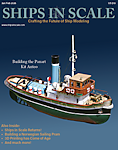
PRE-ORDER SHIPS IN SCALE TODAY!
The beloved Ships in Scale Magazine is back and charting a new course for 2026!
Discover new skills, new techniques, and new inspirations in every issue.
NOTE THAT OUR FIRST ISSUE WILL BE JAN/FEB 2026
You are using an out of date browser. It may not display this or other websites correctly.
You should upgrade or use an alternative browser.
You should upgrade or use an alternative browser.
Need a bit of advice - I got a bit confused by enthusiasm
- Joined
- Dec 30, 2021
- Messages
- 278
- Points
- 278

Noting the age of the ship, and its country of origin, there would I think be common practice applied. Not sure which would be the appropriate one though as I do not know enough about the country of origin to make a specific judgement.
While ships of the early periods were adorned with decoration, the functional aspects of ships were kept fairly simple.
Is it not unusual though that a ship has only one boat?
Certainly English practice is for the ships boats to be secured fore and aft and for stability as close to the centreline as practical. Also means they can be lifted and swayed off either side of the ship depending on the sea state and weather.
While ships of the early periods were adorned with decoration, the functional aspects of ships were kept fairly simple.
Is it not unusual though that a ship has only one boat?
Certainly English practice is for the ships boats to be secured fore and aft and for stability as close to the centreline as practical. Also means they can be lifted and swayed off either side of the ship depending on the sea state and weather.
Peter what you say is correct but perhaps not for that period of time. In putting together the SM I decided to enlarge the hold to make it more interesting. In doing so The boat was placed in position (#3) as per the AL photo plans. Then this brilliant or dumb idea emerged that I should perhaps attempt making a grate - dumb because in the process it verged on reaching for the unopened Black label whiskey left over from my 21st - what I got was an uneven out of square and too thick grate. this was cut in half as per #2. Why the boat was placed on the starboard side is because , in my little mind ships docked on their Port side (not sure if this was correct for that period) which meant that the Starboard side was free to sway the boat over without interfering with loading or off loading of the hold. #1 the grate is made of balsa strips and made to try and better the bamboo one. Think it's best to purchase 'after market' items in future.Noting the age of the ship, and its country of origin, there would I think be common practice applied. Not sure which would be the appropriate one though as I do not know enough about the country of origin to make a specific judgement.
While ships of the early periods were adorned with decoration, the functional aspects of ships were kept fairly simple.
Is it not unusual though that a ship has only one boat?
Certainly English practice is for the ships boats to be secured fore and aft and for stability as close to the centreline as practical. Also means they can be lifted and swayed off either side of the ship depending on the sea state and weather.
The Fernandez-Duo replica (1892) drawings show 1x Launch, 1x Yawl on the deck placed either side of the hold which doesn't appear to give crew much working space.
The reconstruction of the Pinta according to Wilfred Dunn (1985) has the ship look like a Nao and/or the SM. the deck plan drawing places the boat on the Port side of the Hold.
The SM according to the Wolfgang Hinderer project drawing places the large Yawl on the Starboard side of the hold. these were published in the Mechanics magazine (1965)
All modern replicas have Aluminium bottom Inflatables with big outboard motors hanging off the stern or towed behind.. So, peter this is why it's a confusing topic. I think next time I'll just make a ship post 1700's - Cheers
Great feed back gentlemen and modellers. Thank you all very much for the likes and compliments they are very appreciated and certainly help with confidence uplifting.
As voted #2 wins so I'll pursue with finishing it then carry on with the rest of the SM.
Stay safe and enjoy.

As voted #2 wins so I'll pursue with finishing it then carry on with the rest of the SM.
Stay safe and enjoy.


1. You cannot walk between the boat stem and stern and the barrels on the port and the water casks (?) on the starboard.. the boat needs to be rotated to show the reality of sailing a ship. The 'garden gate' is another problem. The hatch in the main deck is loading and offloading. You do not always need to remove the large cross braced hatch cover if you are only transfer a box of tea (or the like). The 'garden gate' may be heavy and require tackle to remove; that can be hard to do when you are in the teeth of a typhoon. The gate boards need to be unconnected so you can remove only one or two boards at a time if that will be enough. Hatch covering boards would probably never be connected on the top. Sailors were barefoot and the discontinuity of the hatch top would have damaged their feet. The same logic applies today when using the main capstan of historic reproductions. Most of the 'rules' of sailing ship are thousands of years old; sailors are among the most conservative people on earth and change nothing willingly. Plans - the plans for literally ALL the Columbus type ships are a disaster. None of them are accurate. Baker, the most knowledgeable naval architect on the subject, wrote two books on them 40 years ago; they are still available. Even Baker will tell you his designs are only a best guess. research (basically book collecting) is the only salvation for a ship modeler. You have to look-up EVERY detail on a plan and get a best consensus of what the detail actually lookedWell I did ask for opinions and it appears I certainly got yours for which I am truly thankful and appreciative. Allow me to reply as follows;
1. #3. I can think of a dozen problems with this configuration (most of them have to do with sail handling and with deck management in heavy weather). Therefore for me, #3 is out.
#3 is based on the original as per the Instruction photos that accompanied the AL Santa Maria kit. Being new to modelling I follow the instructions where possible be they right or possibly wrong.
2. Number two is better. But, the main purpose and function of the grating is to let air into the lower decks. I am not quite sure what the purpose would be in eliminating one-third of the grating and installing a garden fence gate in its' place (especially since you end up with three constructs when the job could be done just as well with two - one fence gate and one grating). Also, there is a 'standard' for deck grates and covers that has planks'
running parallel to the keel or perpendicular to the keel (usually not both) depending upon how the frames, beams and carlings are structured. . There is also a lot of woodwork that supports the ends of the planks in gratings and like structures. There would probably be no supporting structures for the end of the solid boards (unless, of course, you wanted to spend a lot of time energy and money to build totally non-standard decks for no practical gain other than just for the 'hell-of-it'). Also consider that the owner paying the bill would fire you on the spot in a hot second if he observed that the ships chief constructor had absolutely no idea how to build a ship to an almost 'standard' design that had proven itself over a period of about 2,000 years.
2/ I’m not sure what you mean by ‘fence gate’ because many wooden hatches are strengthened in a similar manner with battens be they on top or underneath the planking.
You mention an almost standard design proven over a period of about 2,000 years yet In all publications referring to or relating to the Columbus Ships state that drawings are based on interpretations of what is alleged to be factual. These interpretations differ greatly depending of who the author is and from what evidence conclusions were drawn from.
There is no documented evidence, actual plans, drawings etc of this Nau and the accompaning caravelles Nina/Pinta, so I cannot understand how your ‘Standard design” comes into play regarding these ships. Everything is based on assuptions including those replicas claimed to be built according to the originals.
I doubt very much if Mi Tio Juan would have fired me on the spot because Shipwrights were very few and far between. They didn’t even work to any given plan just built as they went along mostly to protect their construction secrets and work methods. There was no standard to build to.
The Grate standards you refer to are they from the 1490’s era or later periods such as used by Britain, France and Holland?.
Why did I divide and seperate the grates etc? Simply because I struggled to make and assemble them hence used those that were or appeared to be pretty good for my limited skills. Note #3 is made from Bamboo skewers purchased at the local $2 shop.
3. Therefore, I vote for fir #3 (even though it has problems that would have eliminated it as acceptable at the time) . Number three still has the 'fence gate boards' running in the wrong direction, but it is the best of the three. There is also one other problem, The two supports for the boat would have been at the ends of the hatch coverings and they would have rested on the deck (which is built strong enough to support the boat) and not on the hatch coverings (which would not be strong enough to support the boat).
The first heavy seas will probably send the boat directly into the bilge. If you made this change, you could also position the boat along the centerline of the ship, which actually would have been where it would have been positioned. With tthis configuration you can remove the hatch covering planks, access the below deck areas and conduct the ships work with the least amount of unnecessary disruption to the ship's routine. I really think you should make a #4.
#3 is based on the AL instructions as can be seen on the photo below.
Limited as I am on knowledge of ships n boats from the Columbus era I surmise that when in port loading/unloading cargo the row boat would have been off-loaded and tied alongside thereby allowing the hold to be fully opened to received or off load barrels of cargo etc.
Having said all that I thank you very much for your opinion and input. It has been very much appreciated. Cheers Franco (ConsNZ)
View attachment 359560
like. Plans - are, in general, a disaster. The older they are, the worse they are. Most of the 'ship designers' in the kit companies have probably never seen a sailing ship. Thus, their designs are worse than an uninformed guesses. DO NOT TRUST THEM.
By a book on the ship (I usually buy three) and do some research; if you don't find the needed answers, buy some more books.
2000 years old - They have recovered nearly totally preserved merchant Roman merchant ships. In total, they have recovered hundreds of ships. Certain ship details have not changed since the days of the dinosaurs. keels still are fashioned to align fore and aft; for example compare a log canoe and the Ronald Reagan. Ask yourself this question, "how would a 120 pound illiterate semi-starving diseased 20 year old 'boy' do this job at night in the middle of a typhoon? Now, fashion the wood you are working on to represent a tool that would help accomplish the job at hand. Basically, combine your common sense with the plan. I think I have said enough, Good luck.
Hi Franco,
I think you are doing some very nice work here based on the photos you showed at the beginning. I believe sometimes people who have been doing this hobby for a while forget what it feels like to be new at something. And while adhering to a certain accuracy of construction (historically speaking) might be for some - it doesn't have to be your thing. Enjoy yourself and build what makes you happy.
I'm new too, and I try to get it right - but sometimes I miss the mark. I have found the forum members to be typically very polite and understanding - and those who insist on being harsh in their expression eventually tone it down or realize this isn't the right forum for them.
Anyway, I just wanted to encourage you.
I think you are doing some very nice work here based on the photos you showed at the beginning. I believe sometimes people who have been doing this hobby for a while forget what it feels like to be new at something. And while adhering to a certain accuracy of construction (historically speaking) might be for some - it doesn't have to be your thing. Enjoy yourself and build what makes you happy.
I'm new too, and I try to get it right - but sometimes I miss the mark. I have found the forum members to be typically very polite and understanding - and those who insist on being harsh in their expression eventually tone it down or realize this isn't the right forum for them.
Anyway, I just wanted to encourage you.
Hi Franco,
I think you are doing some very nice work here based on the photos you showed at the beginning. I believe sometimes people who have been doing this hobby for a while forget what it feels like to be new at something. And while adhering to a certain accuracy of construction (historically speaking) might be for some - it doesn't have to be your thing. Enjoy yourself and build what makes you happy.
I'm new too, and I try to get it right - but sometimes I miss the mark. I have found the forum members to be typically very polite and understanding - and those who insist on being harsh in their expression eventually tone it down or realize this isn't the right forum for them.
Anyway, I just wanted to encourage you.
Well said Paul
Many thanks Pauls. Your comments are very very appreciated. I enjoy SOS, great members some really entertaining comments but best of all are the positive comments and guidance given unselfishly by members be they Ultra experienced, super artistic or plain too good to be true without forgetting the all important learners hungry for knowledge and loving their builds, boo boo's and mistakes. SOS is a very comforting site, a pleasure to belong to. Keep smiling and good luck with your new build. Cheers.Hi Franco,
I think you are doing some very nice work here based on the photos you showed at the beginning. I believe sometimes people who have been doing this hobby for a while forget what it feels like to be new at something. And while adhering to a certain accuracy of construction (historically speaking) might be for some - it doesn't have to be your thing. Enjoy yourself and build what makes you happy.
I'm new too, and I try to get it right - but sometimes I miss the mark. I have found the forum members to be typically very polite and understanding - and those who insist on being harsh in their expression eventually tone it down or realize this isn't the right forum for them.
Anyway, I just wanted to encourage you.
Too many if’s and buts, much speculation and a great devils advocate for the imagination.1. You cannot walk between the boat stem and stern and the barrels on the port and the water casks (?) on the starboard.. the boat needs to be rotated to show the reality of sailing a ship. The 'garden gate' is another problem. The hatch in the main deck is loading and offloading. You do not always need to remove the large cross braced hatch cover if you are only transfer a box of tea (or the like). The 'garden gate' may be heavy and require tackle to remove; that can be hard to do when you are in the teeth of a typhoon. The gate boards need to be unconnected so you can remove only one or two boards at a time if that will be enough. Hatch covering boards would probably never be connected on the top. Sailors were barefoot and the discontinuity of the hatch top would have damaged their feet. The same logic applies today when using the main capstan of historic reproductions. Most of the 'rules' of sailing ship are thousands of years old; sailors are among the most conservative people on earth and change nothing willingly. Plans - the plans for literally ALL the Columbus type ships are a disaster. None of them are accurate. Baker, the most knowledgeable naval architect on the subject, wrote two books on them 40 years ago; they are still available. Even Baker will tell you his designs are only a best guess. research (basically book collecting) is the only salvation for a ship modeler. You have to look-up EVERY detail on a plan and get a best consensus of what the detail actually looked
like. Plans - are, in general, a disaster. The older they are, the worse they are. Most of the 'ship designers' in the kit companies have probably never seen a sailing ship. Thus, their designs are worse than an uninformed guesses. DO NOT TRUST THEM.
By a book on the ship (I usually buy three) and do some research; if you don't find the needed answers, buy some more books.
2000 years old - They have recovered nearly totally preserved merchant Roman merchant ships. In total, they have recovered hundreds of ships. Certain ship details have not changed since the days of the dinosaurs. keels still are fashioned to align fore and aft; for example compare a log canoe and the Ronald Reagan. Ask yourself this question, "how would a 120 pound illiterate semi-starving diseased 20 year old 'boy' do this job at night in the middle of a typhoon? Now, fashion the wood you are working on to represent a tool that would help accomplish the job at hand. Basically, combine your common sense with the plan. I think I have said enough, Good luck.
You mention William A Baker (21 October 1911 – died 9 September 1981) whom you claim wrote extentively about the Columbus ship.
Published works:
- The new Mayflower, her design and construction, by her designer. Illustrations by R.S. & W.A. Baker. Barre, Mass., Barre Gazette, 1958.
- Colonial vessels; some seventeenth-century sailing craft. Illustrated by the author. Barre, Mass., Barre Pub. Co., 1962.
- The engine powered vessel: from paddle-wheeler to nuclear ship. New York, N.Y.: Grosset & Dunlap, 1965.
- Sloops & shallops Barre, Mass., Barre Pub. Co. 1966; Columbia: University of South Carolina Press, 1988.
- The clipper ship [Exhibition] Hayden Gallery, Massachusetts Institute of Technology, November 14 through December 2, 1966. [Cambridge, Mass.]: The Hayden Gallery, 1966.
- A history of the Boston Marine Society, 1742-1967. Boston: Boston Marine Society, 1968.
- A history of the first 75 years. Cambridge, M.I.T. Dept. of Naval Architecture and Marine Engineering, 1969.
- C. J. A. Wilson’s Ships. With notes and comments by William A. Baker. Introd. by Richard B. Holman. Barre, Mass., Barre Publishers, 1971.
- New England and the sea, by Robert G. Albion, William A. Baker, and Benjamin W. Labaree. Marion V. Brewington, picture editor. Middletown, Conn., Published for the Marine Historical Association, Mystic Seaport, by Wesleyan University Press [1972].
- "Maritime History of Bath Maine and the Kennebec River Region, Vol. I and Vol . II" Marine Research Society of Bath, 1973
- Maine shipbuilding: A bibliographical guide. Portland: Maine Historical Society, 1974.
- The Mayflower and other colonial vessels. Annapolis, Md.: Naval Institute Press, A 1983.
Also I believe you should direct your very strong personal opinions to the following Authors/Publications that I have used to guide me in putting together my personal version of the 1/65 AL SM.
1/ “Anatomy of the Ship – The ships of Christopher Columbus” by Xavier Pastor.
First published 1992 Conway marine Press ISBN 0-85177-585-3
2/ “The ships of Christopher Columbus” by Franco Gay & Cesare Ciano.
Published 1996 Istituto Poligrafico e Zecca Dello Stato Libreria Dello Stato Roma. Edited and Translated by the Ohio State University – ISBN10 8824037682, ISBN13 9788824037686.
This discussion/debate is now closed. I asked for an opinion SOS members voted. Number 2 wins, END OF STORY. Nothing further needs to be said.
Drawings show placement of boats on main Carrack/Nao decks. Illustrated by, I presume, well informed people who study the Meditteranean Ships of that era. - ciao and cheers.
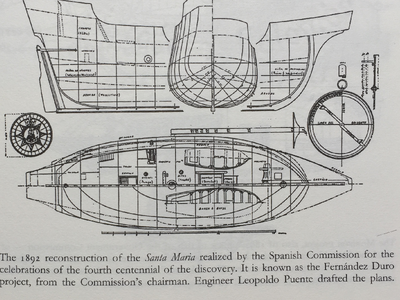
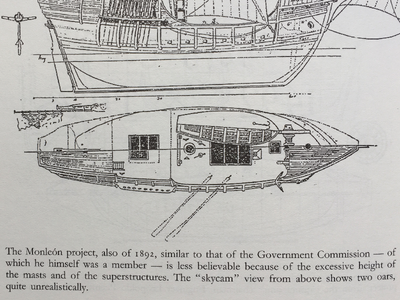
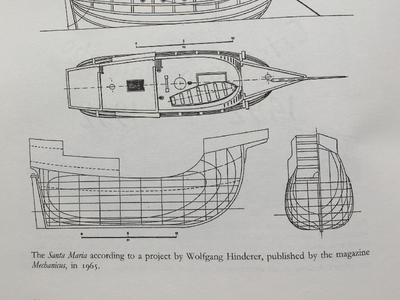
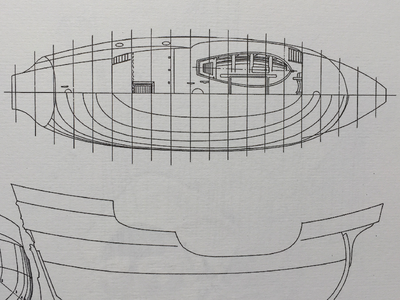
Interesting to note how on these early ships, with very little working room on deck, the most practical choice was made to store the boat to the side and off the top of the grating so it would not completely interfere with ventilation or loading/offloading the vessel. It makes perfect sense. The weight of the boat would not affect ship's heel angle all that much, and you really need fresh air below to keep the space and the timbers as dry as possible to preserve the hull and the food stores.
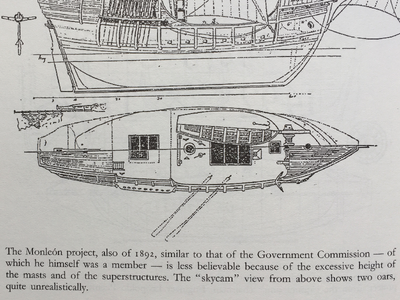
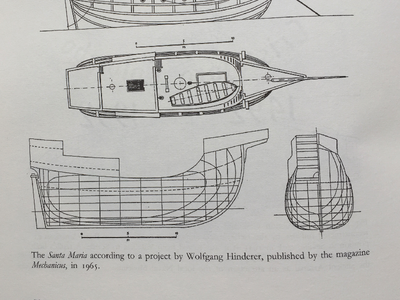


Thank you, Kurt, your insight and knowledge of ships is unbelievable. It's no wonder that I try to follow your builds, advise, read as many DA comments as possible providing my computer isn't in a frozen 'lets be annoying mood. Cheers you made my morning Super Awesome.Interesting to note how on these early ships, with very little working room on deck, the most practical choice was made to store the boat to the side and off the top of the grating so it would not completely interfere with ventilation or loading/offloading the vessel. It makes perfect sense. The weight of the boat would not affect ship's heel angle all that much, and you really need fresh air below to keep the space and the timbers as dry as possible to preserve the hull and the food stores.


Hallo @ConsNZMade three different version of my version of the Santa Maria Hold. Before carrying on and completing them and then using only one on the eventually finished model. Could I please have an opinion as to which one looks preferable. Thank you.
View attachment 359317
View attachment 359318
View attachment 359319
View attachment 359320
we wish you all the BEST and a HAPPY BIRTHDAY

Hi Franco,
All the best for a wonderful birthday!
All the best for a wonderful birthday!
Thank you very much. Happy Easter to you and loved ones.
Thank you, Family gathering, relaxing time surrounded by boisterous grandchildren. Happy Easter to you and yours.Hi Franco,
All the best for a wonderful birthday!





